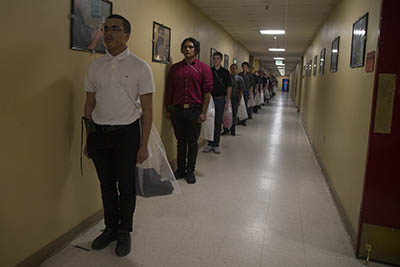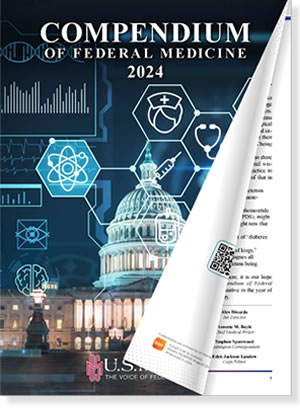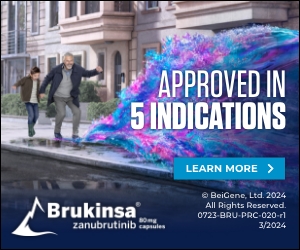CHARLOTTESVILLE, VA—Despite significant rates of sudden cardiac death in recruits and the devastating impact of SCD on military missions, the DoD discontinued universal electrocardiogram screening for recruits and officer candidates nearly 20 years ago.
Now, researchers are questioning whether that should be brought back.

New recruits with Bravo Company, 1st Recruit training Battalion, stand in line to receive their initial haircuts at Marine Corps Recruit Depot, San Diego, March 30, 2020. Recruits received haircuts immediately after arriving to create uniformity. Marines and recruits on MCRD practice social distancing when possible for everyone’s overall health and to prevent the spread of COVID-19. (U.S. Marine Corps photo by Cpl. Brooke C. Woods)
A study team from the University of Virginia and the Uniformed Services University of the Health Sciences thinks it’s worth evaluating, particularly in light of the high rate of cardiovascular issues that terminate deployments.
“The importance of accurately identifying military applicants (officer and enlisted) with cardiovascular disease is difficult to exaggerate,” noted Charles Magee, MD, of the University of Virginia in Charlottesville, VA, and Mark Haigney, MD, of the USUHS in Bethesda, MD, in a recent article in Military Medicine.1
“In 2007, more than half of those medically evacuated from Iraq and Afghanistan to Landstuhl had cardiovascular chief complaints, versus only 20% for combat wounds,” they said.
Disqualifying Cardiac Disease Potentially Identified by ECG Screening
| ECG Likely to Identify | ECG Not Likely to Identify |
|---|---|
| Atherosclerotic coronary artery disease | |
| Hypertrophic cardiomyopathy (HCM) | Coronary anomalies |
| Arrythmogenic right ventricular cardiomyopathy (ARVC) | Catecholaminergic polymorphic ventricular tachycardia (CPVT) syndrome |
| Long/short QT syndromes | Idiopathic ventricular fibrillation |
| Brugada syndrome | Commotio cordis |
| Congenital AS | |
| Myocarditis (if concomitant myopericarditis) |
Sudden unexplained death is the No. 1 cause of nontraumatic sudden death in U.S. servicemembers, and sudden cardiac death is the primary cause of these deaths among both enlisted recruits in training and active duty personnel.
Identifying the recruits and officer candidates at risk of significant cardiac events could have important implications for military forces.
SCD Costs
“Every sudden cardiac arrest survivor with brain damage costs the Military Health System millions of dollars,” Magee told U.S. Medicine. ECGs can reveal pathologies in 75% to 90% of known causes of sudden cardiac death.
Reported Incidences of SCD Across Relevant Clinical Populations (per 100,000 Person Years)
| Reported Incidences of SCD Across Relevant Clinical Populations (Expressed per 100,000 Person-Years) | |||||
|---|---|---|---|---|---|
| Overall | Male | Female | AA | Non-AA | |
| Military recruits (DoD-RMR) | 6.6* | 7.1* | 3.8* | 12.0* | 5.3* |
| Active duty military (DoD-CDR) | n/a | 6.7 | 1.4 | n/a | n/a |
| NCAA athletes | 2.3 | 3.0 | 1.3 | 5.7 | 1.7 |
|
Note: DoD-RMR, Department of Defense Recruit Mortality Registry; DoD-CDR, Department of Defense Cardiovascular Death Registry; AA, African American; Non-AA, Non-African American. *Does not include sudden deaths with normal autopsy findings and so may be an underestimate of cardiac deaths. |
|||||
“ECGs can identify the presence of nonlethal conditions as well, like Wolff-Parkinson-White syndrome, that also cost the MHS to address,” he added. Notably, Wolff-Parkinson-White, latent hypertrophic cardiomyopathy and other asymptomatic conditions may only be identified by ECG screening.
The costs go well beyond those associated with care for survivors, however. “This financial valuation does not include the important cost of losing a servicemember while serving, the impact to mission, and the impact to servicemembers around them,” Magee said.
Between 1977 and 2001, more than half of the 126 nontraumatic sudden deaths were attributed to SCD and 108 of them occurred during exercise and the majority were associated with a cardiac abnormality on autopsy. Another 12 were associated with sickle cell trait and the balance could be explained by non-structural arrhythmic syndromes, according to the researchers.
Servicemembers and recruits, especially, have rates of sudden cardiac death almost three times that of National Collegiate Athletic Association athletes for whom screening ECGs have become standard practice.
Overall, NCAA athletes experience sudden cardiac death at a rate of 2.3 per 100,000 person years compared to at least 6.6 per 100,000 person years for military recruits age 19 or less and 14.4 per 100,000 person years for those over age 25. Looking at males only, the athletes had an SCD rate of 3.0 compared to 7.1 among recruits and 6.7 in active duty military per 100,000 person years.
Notably, the reported rate of sudden cardiac death among recruits does not include sudden deaths with normal autopsy findings. In most cases, “the assumption is that sudden death with a normal autopsy is a cardiac event,” Magee explained.
Greater Accuracy
A number of developments have increased the value of the ECG for screening young people since the DoD abandoned universal ECG screening in 2002.
In recent years, as the ECG has become a critical component of screening for high-risk athletics, new algorithms have made the test far more suitable for evaluation of fit young people and prospective warrior athletes.
“First and foremost, development of athlete-specific normal values has greatly reduced false positives that are due to the athletic heart,” Magee said. Further, “ECG computer algorithms have employed these advances with promising results and are widely available.”
Updated ECG algorithms designed for athletes, such as the Seattle Criteria, eliminate the great majority of abnormal findings that are actually typical of a healthy athletic heart, such as sinus bradycardia and first-degree atrioventricular block. These characteristics accounted for 94% of the abnormal findings identified using traditional ECG criteria in a review of test results among candidates for a military pilot training program, Magee and Haigney noted.
Until relatively recently, the ECG has been subject to significant interrater variability. Automated ECG algorithms using the Seattle Criteria or similar schema have markedly increased consistency in interpretation as well as accuracy and reliability in studies of NCAA athletes.
The cost of an ECG alone is quite modest. The DoD recently awarded a contract to provide ECG interpretation within 24 hours for less than $30 per ECG, according to the authors. Incorporating ECG as a standard part of screening for recruits and officer candidates would increase the use of other diagnostic tests as well.
A study of 5,258 athletes in the American Journal of Cardiology found that “only 198 had ECG abnormalities (3.7%). These abnormalities led to 135 echocardiograms (2.5%), 108 cardiology consultations (2.1%), 26 exercise stress tests (0.05%), and even fewer stress echocardiograms, cardiac MRIs, and other studies to confirm the diagnosis,” Magee said.
“The bottom line, assuming military recruits are similar to NCAA athletes, if every positive ECG generated an echocardiogram or other follow-on testing, we would expect secondary testing to be necessary to confirm a diagnosis in less than 5% of the population,” he added.
- Magee C, Haigney MC. Cardiovascular Screening in the U.S. Military: Time to Reconsider the Electrocardiogram. Military Medicine. 17 Feb 2020; pii:usaa002.


